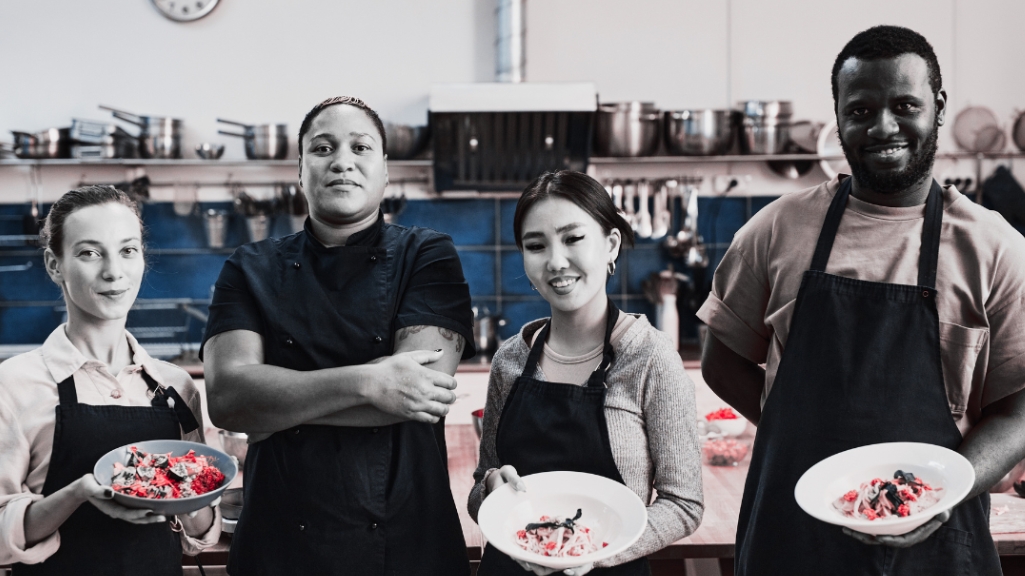Matt Frauenshuh Describes the Effect of Diversity & Inclusion on the Restaurant Industry

In the context of the restaurant industry, diversity and inclusion take on a unique significance. The restaurant sector is renowned for its vibrancy and dynamism, reflecting a melting pot of cultures, flavors, and traditions. Restaurants are not just places to dine but communal spaces where society comes together, making the industry a powerful influencer in shaping cultural and social norms. Given this central role, it is paramount for restaurants to embody and promote diversity and inclusion. This ensures that the diverse tapestry of the communities and customers they serve is mirrored in the workforce and the dining experience offered, fostering a richer, more inclusive community fabric.
As the CEO of Fourteen Foods, the nation’s largest owner of DQ Grill & Chill franchise locations, Matt Frauenshuh recognizes the need for continued growth and change for the restaurant industry to become more inclusive. While there is a growing presence of diversity, particularly at the entry and mid-level positions in restaurants, the diversity diminishes significantly at the managerial and executive levels. According to data from the U.S. Bureau of Labor Statistics, as of 2022, around 40% of cooks and 60% of servers are people of color. Additionally, the restaurant industry has a higher representation of women compared to many other sectors.
While representation continues to improve, women and minorities continue to be underrepresented in leadership positions, accounting for a small fraction of executive chefs and restaurant owners. Wage gaps and limited access to capital for minority-owned businesses further exacerbate this disparity.
Matt Frauenshuh lends his voice to the important discussion of diversity and inclusion in the restaurant industry.
Societal Shifts and Movements for Change
The current state of diversity and inclusion in the restaurant industry has been influenced by societal movements demanding equality and accountability. Initiatives for equal pay, greater representation, and fair work practices have prompted a reckoning within the industry, pushing restaurants to confront issues of systemic racism and inequality. Similarly, women’s movements have shed light on the prevalence of sexual harassment and discrimination in the workplace, leading to calls for safer and more respectful working conditions. These movements have resulted in a shift in public expectations and accountability.
“Consumers are increasingly aware of and concerned about social justice issues, and they are using their purchasing power to support businesses that align with their values,” says Matt Frauenshuh. “Restaurants are feeling the pressure to not just talk, but also walk the walk when it comes to diversity and inclusion.”
The impact of these societal shifts is palpable. Restaurants are taking active steps to address disparities, implement inclusive policies, and create a culture of belonging. Diversity and inclusion training programs are becoming more common, and there is a growing recognition of the need to provide mentorship and career advancement opportunities to underrepresented groups. The industry must continue to reflect on its practices, confront its biases, and take tangible steps toward creating a more inclusive and equitable space for all.
The influence of societal movements and the demands of a more aware and discerning public serve as catalysts for change, pushing the industry toward a more diverse and inclusive future. Embracing diversity and inclusion within the restaurant industry goes beyond fulfilling a moral obligation; it catalyzes innovation, enhanced performance, and stronger customer relationships. When different perspectives and backgrounds come together, it enriches the culinary experience, fosters a positive work environment, and resonates with a diverse clientele.
Enhanced Creativity and Innovation
The culinary world thrives on creativity and innovation, and diverse teams are at the heart of its success. When chefs and staff from varied backgrounds, cultures, and experiences collaborate, they bring unique flavors, ingredients, and techniques to the table. For instance, a kitchen team comprising members from different ethnic backgrounds might fuse traditional dishes from their respective cultures, leading to innovative and unique menu offerings. This not only sets a restaurant apart but also caters to the growing consumer desire for diverse and global dining experiences. Diversity enhances problem-solving and decision-making. A team with varied perspectives can approach challenges from multiple angles, leading to more comprehensive and effective solutions.
Creating an inclusive work environment directly correlates with employee satisfaction and productivity. When employees feel valued and included, it fosters a sense of belonging and commitment to the workplace, resulting in higher morale and engagement. Diverse teams also draw from a broader set of skills and experiences, leading to improved performance and innovation. Inclusion plays a crucial role in recruitment and retention, especially in the restaurant industry, which often struggles with high turnover rates.
Notes Frauenshuh, “By cultivating an inclusive environment, restaurants become attractive workplaces for a wide talent pool, aiding in both attracting and retaining employees.”
The restaurant industry is inherently customer-focused, and reflecting the diversity of the customer base strengthens the connection between the business and its clientele. Customers appreciate seeing themselves represented in the staff and the menu offerings, creating a more welcoming and relatable dining experience. This alignment not only attracts a broader customer base but also fosters customer loyalty. A diverse and inclusive restaurant is likely to have a better reputation, as it reflects a commitment to equality and social responsibility. In today’s socially conscious environment, this can be a significant differentiator and driver of customer preference.
The benefits of embracing diversity and inclusion in the restaurant industry are manifold. From fueling culinary innovation and enhancing team performance to building stronger connections with customers, the positive impacts are felt across all aspects of the business. Promoting diversity and inclusion in the restaurant industry is not a passive endeavor; it requires intentional strategies and commitment from all levels of the organization. Effective leadership, comprehensive training, and inclusive policies are essential components of this transformative journey.

Leadership and Accountability
Leadership plays a crucial role in setting the tone and expectations for diversity and inclusion within a restaurant. Leaders must demonstrate a genuine commitment to these values, modeling inclusive behavior and fostering a culture that celebrates diversity. This involves recognizing and addressing any existing biases and ensuring that diversity and inclusion are integrated into the organization’s core values and mission. Accountability mechanisms are vital to ensure that these values are upheld. This could include setting diversity and inclusion goals, regularly reviewing progress, and holding all staff members accountable for contributing to an inclusive environment. Leaders should also be open to feedback and prepared to make necessary changes to policies and practices to enhance diversity and inclusion.
Providing training and education on diversity and inclusion is crucial for building awareness and skills among staff members. This can include formal training programs, workshops, and resources that cover topics such as unconscious bias, cultural competency, and inclusive communication. It’s important that this training is not a one-time event but an ongoing effort that is integrated into the restaurant’s regular operations.
“Best practices for effective diversity and inclusion training include making it interactive, relevant, and actionable, ensuring that staff members can apply what they have learned in their day-to-day work.” Says Frauenshuh.
Providing opportunities for staff members to share their experiences and perspectives can enrich the learning experience and foster a sense of belonging.
Implementing inclusive policies and practices is a tangible way to demonstrate a restaurant’s commitment to diversity and inclusion. This can include equitable hiring practices, providing equal opportunities for advancement, and implementing a zero-tolerance policy for discrimination and harassment. It’s important to regularly review and update these policies to ensure they are effective and reflect the restaurant’s values. Creating an inclusive work environment also involves paying attention to the small details that can make a big difference, such as using inclusive language, providing accessible facilities, and celebrating cultural events and holidays. Seeking input from staff members on diversity and inclusion initiatives can provide valuable insights and ensure that the restaurant’s efforts are responsive to the needs of all employees.
Potential Backlash and Resistance
Change, even positive change, can be met with resistance. In the context of promoting diversity and inclusion, this resistance might come from employees or customers who are unaccustomed to or uncomfortable with these changes. For instance, long-standing staff members might feel threatened or uneasy about new inclusive policies or practices, perceiving them as unnecessary or as a challenge to the status quo. Customers, too, might have biased views and resist frequenting a restaurant that actively promotes diversity.
To address and overcome this resistance, education, and communication are key. It’s essential to articulate the value and importance of diversity and inclusion, not just as a social responsibility, but as a strategy for enhancing the restaurant’s culture, innovation, and customer relations. Training and resources can help dispel myths and biases, fostering a more inclusive mindset. It’s also crucial to create a safe and open environment where concerns can be voiced and addressed constructively.

Balancing Authenticity and Inclusivity
Another challenge lies in balancing the maintenance of a restaurant’s authenticity while striving for inclusivity. For instance, a restaurant that specializes in cuisine from a particular culture might grapple with how to maintain the authenticity of its offerings while ensuring its menu and atmosphere are inclusive and welcoming to a diverse clientele. The key to navigating this balance is a genuine commitment to both authenticity and diversity. This means valuing and preserving the unique aspects of the restaurant’s culture or cuisine, while also being open to adaptation and innovation. It might involve educating customers about the cultural significance of certain dishes or incorporating a variety of dishes that cater to different preferences and dietary needs.
“Diversity and inclusion should not be treated as a box-checking exercise or marketing ploy,” says Frauenshuh.
Customers and employees are increasingly savvy and can discern when initiatives are superficial or performative. Authenticity in diversity and inclusion efforts requires a deep commitment from leadership and staff, and a willingness to make meaningful changes to policies, practices, and culture. While promoting diversity and inclusion in the restaurant industry is essential and beneficial, it is not without its challenges. Organizations may face resistance, and there is a need to balance authenticity with inclusivity. By addressing these challenges head-on, with education, communication, and genuine commitment, restaurants can create a more inclusive and enriching environment for all.
A Future of Inclusion & Diversity
The restaurant industry’s journey towards diversity and inclusion is imperfect but moving toward real change, reflecting a broader societal shift towards equality and representation. Looking forward, the industry is poised for further transformation, with trends indicating an increased emphasis on equitable practices and inclusive environments. This necessitates a sustained commitment from industry leaders and stakeholders to drive change and uphold inclusive values. Ultimately, the pursuit of diversity and inclusion is not just a moral imperative but a strategic one, integral to the industry’s innovation, employee satisfaction, and customer loyalty. Embracing these values fully is paramount for a more equitable, resilient, and vibrant future in the restaurant industry.
Most Inside
Most Inside offers high-quality recommendations and valuable updates to enhance all aspects of your life, providing premium guidance and enriching experiences.




